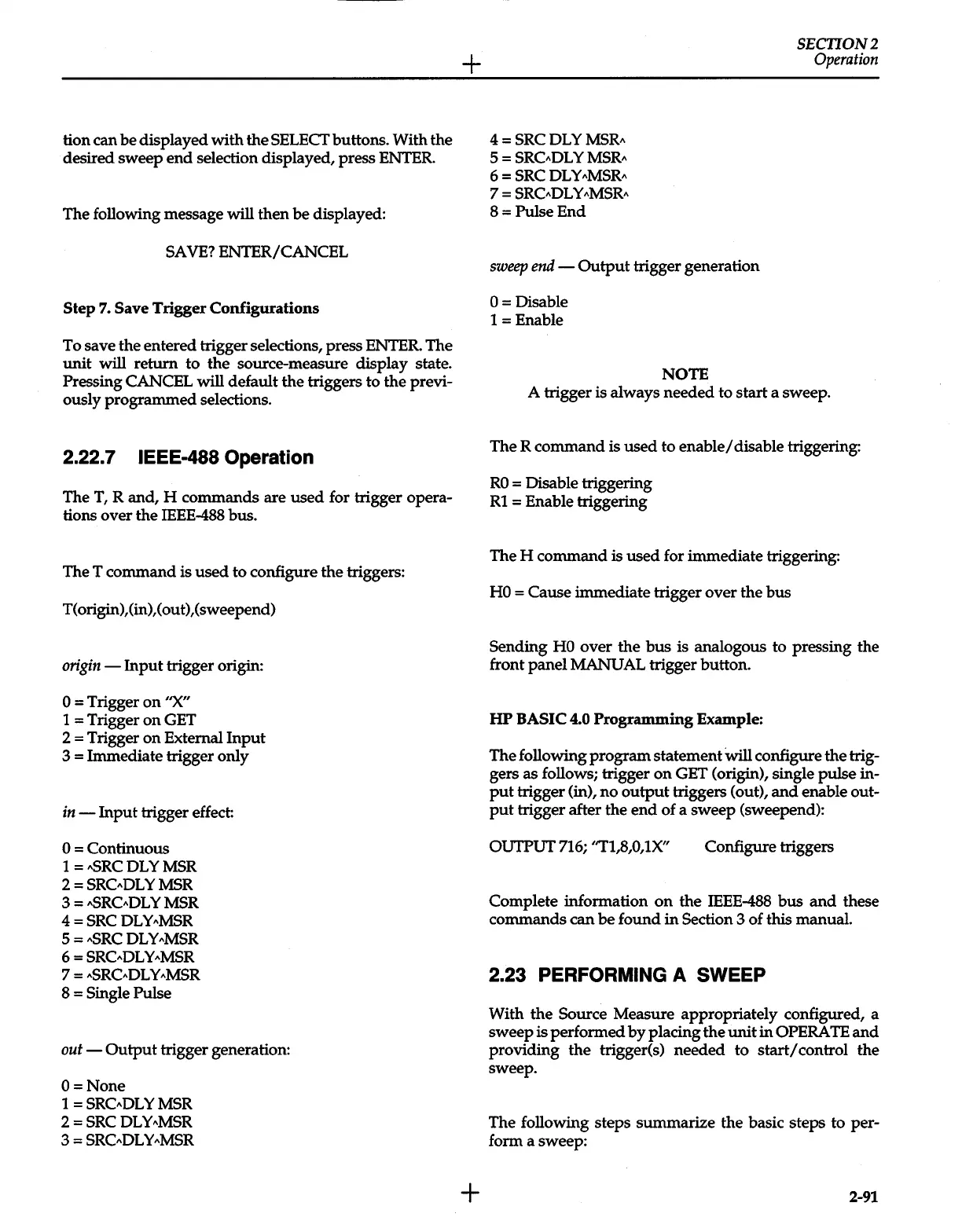tion can
be
displayed
with
the
SELECT buttons. With the
desired
sweep
end
selection displayed, press ENTER
The following message
will
then
be
displayed:
SAVE?ENTER/C~CEL
Step
7.
Save Trigger
Configurations
To save
the
entered trigger selections, press ENTER The
unit
will
return
to
the
source-measure display state.
Pressing
C~CEL
will
default
the
triggers to
the
previ-
ously
programmed
selections.
2.22. 7 IEEE-488 Operation
The
T,
R and, H commands are
used
for trigger opera-
tions over the IEEE-488 bus.
The T command is
used
to configure
the
triggers:
T(
origin) ,(in),( out) ,(sweepend)
origin
-Input
trigger origin:
0 = Trigger
on
"X"
1 = Trigger
on
GET
2 = Trigger
on
External
Input
3 = Immediate trigger only
in
-
Input
trigger effect:
0 = Continuous
1 =
"SRC
DLY
MSR
2 = SRC"DLY MSR
3 =
"SRC"DLY
MSR
4=SRCDLY"MSR
5 =
A5RC
DLY
"MSR
6 = SRC"DLY"MSR
7 = "SRC"DLY"MSR
8 = Single Pulse
out-
Output
trigger generation:
O=None
1 = SRC"DLY MSR
2 =
SRC
DLY"MSR
3 = SRC"DLY"MSR
+
+
SECTION2
Operation
4 = SRC
DLY
MSR"
5 = SRC"DLY
MSR"
6 =
SRC
DLY"MSR"
7 =
SRC"DLY"MSR"
8=PulseEnd
sweep
end
-Output
trigger generation
0
=Disable
1
=Enable
NOTE
A trigger is always
needed
to start a sweep.
The R
command
is
used
to
enable/
disable triggering:
RO
= Disable triggering
Rl
= Enable triggering
The H
command
is
used
for immediate triggering:
HO
= Cause immediate trigger over
the
bus
Sending
HO
over
the
bus
is analogous to pressing the
front
panel
MANUAL trigger button.
HP
BASIC 4.0
Programming
Example:
The
following
program
statement
Will
configure
the
trig-
gers as follows; trigger
on
GET (origin), single pulse in-
put
trigger (in),
no
output
triggers (out),
and
enable out-
put
trigger after the
end
of
a
sweep
(sweepend):
OUTPUT
716; "T1,8,0,1X"
Configure triggers
Complete information
on
the
IEEE-488
bus
and
these
commands can
be
found
in
Section 3
of
this manual.
2.23 PERFORMING A SWEEP
With
the
Source Measure appropriately configured, a
sweep
is performed
by
placing
the
unit
in
OPERATE
and
providing
the
trigger(s)
needed
to
start/
control the
sweep.
The following steps summarize the basic steps to per-
form a sweep:
2-91
